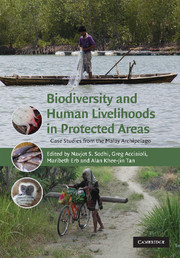Book contents
- Frontmatter
- Contents
- List of contributors
- Acknowledgements
- 1 General introduction
- Part I Conservation needs and priorities
- Part II Conservation with and against people(s)
- 11 Introduction to Part II
- 12 Collaboration, conservation, and community: a conversation between Suraya Afiff and Celia Lowe
- 13 Hands off, hands on: communities and the management of national parks in Indonesia
- 14 Conservation and conflict in Komodo National Park
- 15 Another way to live: developing a programme for local people around Tanjung Puting National Park, Central Kalimantan
- 16 For the people or for the trees? A case study of violence and conservation in Ruteng Nature Recreation Park
- 17 Seas of discontent: conflicting knowledge paradigms within Indonesia's marine environmental arena
- 18 Strategy and subjectivity in co-management of the Lore Lindu National Park (Central Sulawesi, Indonesia)
- 19 Indigenous peoples and parks in Malaysia: issues and questions
- 20 Protecting Chek Jawa: the politics of conservation and memory at the edge of a nation
- 21 Integrating conservation and community participation in protected-area development in Brunei Darussalam
- 22 Conclusion to Part II
- Part III Legal and governance frameworks for conservation
- 29 General conclusion
- Index
- References
20 - Protecting Chek Jawa: the politics of conservation and memory at the edge of a nation
from Part II - Conservation with and against people(s)
Published online by Cambridge University Press: 12 November 2009
- Frontmatter
- Contents
- List of contributors
- Acknowledgements
- 1 General introduction
- Part I Conservation needs and priorities
- Part II Conservation with and against people(s)
- 11 Introduction to Part II
- 12 Collaboration, conservation, and community: a conversation between Suraya Afiff and Celia Lowe
- 13 Hands off, hands on: communities and the management of national parks in Indonesia
- 14 Conservation and conflict in Komodo National Park
- 15 Another way to live: developing a programme for local people around Tanjung Puting National Park, Central Kalimantan
- 16 For the people or for the trees? A case study of violence and conservation in Ruteng Nature Recreation Park
- 17 Seas of discontent: conflicting knowledge paradigms within Indonesia's marine environmental arena
- 18 Strategy and subjectivity in co-management of the Lore Lindu National Park (Central Sulawesi, Indonesia)
- 19 Indigenous peoples and parks in Malaysia: issues and questions
- 20 Protecting Chek Jawa: the politics of conservation and memory at the edge of a nation
- 21 Integrating conservation and community participation in protected-area development in Brunei Darussalam
- 22 Conclusion to Part II
- Part III Legal and governance frameworks for conservation
- 29 General conclusion
- Index
- References
Summary
Introduction: the reprieve at Chek Jawa
In December 2001, conservationists in Singapore scored a rare victory when they convinced the government to stop land reclamation at Tanjung Chek Jawa, probably the last coastal flats in the country. Only one square kilometre in area, Chek Jawa cradles six ecosystems and is situated at the edge of Pulau Ubin, itself a rustic island of slightly more than ten square kilometres in size at the north-eastern edge of the country (Fig. 20.1). It was no small feat. The conservation of disorderly wilderness was not a consideration of the developmental state, which preferred an orderly city in a manicured garden. The last time conservationists won a reprieve for nature was in 1992, when the government shelved plans to clear rainforests to develop a golf course in the Central Catchment Reserve. Through the 1990s, Ubin was a focus of contention between conservationists aiming to protect pockets of nature areas and a technocratic government planning to build a housing estate. Caught in this tussle was a nostalgic public that saw Ubin as the last kampung (Malay: village) in Singapore. In mid 2001, the government put aside its plans for Ubin in recognition of public sentiment, but indicated that land reclamation along its eastern shoreline would proceed as planned.
In the second half of 2001, a public campaign to save Chek Jawa gathered momentum.
- Type
- Chapter
- Information
- Biodiversity and Human Livelihoods in Protected AreasCase Studies from the Malay Archipelago, pp. 311 - 329Publisher: Cambridge University PressPrint publication year: 2007



